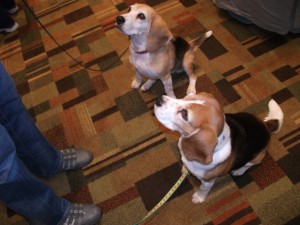Hi everyone!
Just on break between my last session and dinner so I thought I’d blog a bit about Day 1 lectures and workshops!
Session 1: Ken Ramirez, Aggression: Treatment and Context
This presentation categorized and summarized many of the aggression treatment protocols commonly in use in science-based training. Classical Counter-Conditioning, Constructional Aggression Treatment, Incompatible Behaviors (Watch me), Look at That, Click to Calm, etc. were all covered quickly, and Ken presented his opinions, pros, and cons of each. Most of the content of this presentation was review for me (since dog aggression is an area I spend a lot of time studying and working on in the field), however, here are a few interesting points I picked up:
- Ramirez asserts that training Incompatible Behaviors (Watch-Me) is an excellent tool to prevent the rehearsal of aggression and to keep animals safe. However, he clearly states that these approaches do not solve the aggression problem by itself. This is something I figured out by accident, which is why I incorporate Behavior Adjustment Training now in the treatment of dog reactivity.
- Ramirez showed a video of Kellie Snider in a CAT exercise with a Doberman that is aggressive to strangers that visit their home and has a bite history. The video showed clips of a 38 minute protocol where initially, the dog would bark and lunge at the sight of Kellie (over threshold), but only at the precise moment the Doberman relaxed would she leave. If the dog barked as she was leaving, she would return. After 50 repetitions (roughly), she was able to greet the dog and feed the dog treats, and shortly thereafter she was able to pet the dog on the head. The video itself was quite amazing in that a) she is incredibly brave – the dog was unmuzzled, has a bite history, and was only restrained on leash and being held by a pre-teen boy and b) this dog had never allowed a stranger to come into their home in many years.
- Ramirez did not discuss BAT (Behavior Adjustment Training) as he is not familiar enough with it at this time. A bit disappointing, since it is my favorite protocol for reactivity now.
Session 2: Michele Pouliot – Anticipation is Making Me Great!
Michele is a world champion canine freestyle competitor – which is exactly why I took this track (I know very little about Canine Freestyle). The topic of this presentation was how to use a dog’s anticipation to your advantage as a training tool.
If you have ever had a dog anticipate your cue and break a start line stay, or impatiently begin offering behaviors prior to the cue, here are some takeaways (Petey is a chronic jump-the-gun dog, and I’m delighted that she frames this “problem” into an advantage)
- Anticipation when harnessed creates energetic and immediate (low latency) behavior
- Most errors of dogs starting before cued are handler errors – extraneous cues the handler gives unconsciously – video taping yourself is the best way to troubleshoot this
- Never correct (even mildly) a dog that anticipates and starts before the cue – you will kill their enthusiasm
- Create a “Start-Ready” dog by creating a cue that tells the dog “the first cue is coming” so they know to get energized, focus, and wait for the first “real” cue
- Use a “wait” cue and reinforce it either with a primary reinforcer (c/t) or cueing the actual behavior.
Session 3: Cecilie Køste – Top OTCh Skills for Top Obedience
Cecilie is world class competitive obedience trainer from Norway. This is another area I really don’t know much about, so I was thrilled to have a chance to hear her present in person (tomorrow I am attending a hands on workshop with her on the same topic).
A key concept in their training method is to teach a set of 18 “basic skills” that have no cues, then assemble them finished behaviors fluent with very high criteria, then backchain them into performance behaviors, and then assemble routines through backchaining. The analogy she used is “Letters to Words to Sentences”.
Since I’m working on getting Petey ready for Rally-O Trials, I’ll blog more about this separately but here are a few neat points I wanted to share tonight:
- They are BIG on Doggy-Zen proofing. All behaviors in the basic set must be performed with food scattered on the floor or in bowls – once the dog has performed the behavior, a release cue is given to go to the food (or toy)
- A new term… “reverse luring” – where lures are presented and the dog must ignore the lure and maintain position (a variation of doggy-zen)
- No cues are given to basic behaviors – so each session is compartmentalized to focus on one of the 18 basic behaviors. How does the dog know which behavior is being worked on? The dog offers all 18 and you just c/t the one you are working on in a session.
Two videos that were quite impressive was a dumbell hold while hot dogs were placed on the dumbell, and a dumbell retrieve where the dumbell is thrown right next to a bowl of food (zen to the nth degree!)
Time for dinner! Stay tuned for Day Two tomorrow. Comment below if you have questions!
Lastly… BEAGLES AT CLICKER EXPO!

